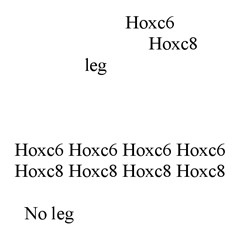Lecture notes for Monday, April 27, 2009
Evolutionary Developmental Biology
Embryological phenomena have different kinds of causes:
-
Functional
Genetic
Mechanical
Evolutionary
Genes evolved that produce a shape that serves a function...etc.
None of the 4 is more fundamental than the other 3. They are interrelated.
Evolutionary changes depend on genetic changes that change structures.
Historically, scientists have concentrated first on one kind of cause, then focused more on some another kind, then switched to another.
Recapitulation Ernst Haeckel
A concept based on mis-application of Darwin's evolution.
Haeckel's theories were dominant between about 1870-1900 or later.
The famous cliché "Ontogeny recapitulates phylogeny"
Meaning that the shape changes of embryonic development are speeded-up
versions of changes that occurred during evolutionary history of each kind of animal.
Be careful not to open chicken eggs while they are recapitulating dinosaurs!
(I am joking.)
Recapitulation is an exaggeration; but with some truth.
Gill slits, notochord, very similar cell lineages among spirally-cleaving species:
are all explainable only by shared ancestry.
If we hadn't evolved from fish, our embryos wouldn't have gill slits
Even though we now use our gill slits to form the ear canal, the tonsils, the thymus "gland", and the parathyroid gland.
(and notochords are evidence that both we and fish evolved from sea squirts).
*********************************************************
In the last couple decades there have been big surprises about certain families of transcription factor genes that control organ formation.
For example, insect eyes have very different structures than vertebrate eyes,
and their embryonic development is rather different, too!
Yet some of the transcription factors that control the locations of eye development turn out to have very similar amino acid sequences in flies as in mice. Pax6 gene
Putting copies of mouse genes and Pax-6 proteins causes cause flies to form compound eyes in abnormal locations.
The reverse experiment also works; putting copies of fly Pax-6 genes into Xenopus frog embryos can cause them to form extra eyes at abnormal places.
Three other genes also found both in vertebrates and flies, and stimulate and are needed for eye development.
"Sine oculis", "eyes absent" and "dachshund."
But fly tissues always form compound eyes,
and vertebrate tissues always form "camera eyes" (hollow, with a retina & lens)
Maybe both kinds of eyes evolved from some very simple eyes or eye-spots of flatworms? And the transcription factor proteins that stimulate expression of the rest of the eye genes stayed the same, cven though vertebrates then evolved completely different kinds of eye structures than arthropod eyes? It's anybody's guess.
What do you think?
------------------------------------------------------------------------------
Notice that geneticists often name genes after whatever happens as a result of mutating that gene. That's the opposite of the real function of the normal version of the gene.
For example, what is the normal function of the "eyes absent" gene?
To cause eyes to develop? Or to cause eyes NOT to develop?
I used to predict that when geneticists found a gene that was necessary to form the heart, they would name it the "heartless gene"
Because mutation of this gene would cause the heart not to form!
But my prediction was wrong: They named that gene "tinman"
Because in the children's story and well-known movie, the Wizard of Oz, there is a character called the Tin Man that doesn't have a heart and wants to get one. Another character, the Scare-Crow, wants a brain, and the Cowardly Lion wants courage.
Question: if somebody named a gene "Scare-Crow", or "Cowardly Lion" what would the phenotypes of mutants of those genes be?
What would the normal functions of those genes be?
++++++++++++++++++++++++++++++++++++++++++++++++
Hearts have very different locations and structures in arthropods as compared with vertebrates
But tinman genes were found in flies and in vertebrates
And very similar distal-less genes are expressed (locally transcribed)
-
At the outer ends of fly legs.
Along the outer edge of vertebrate limb buds.
At the ends of sea urchin tube feet.
In the middle of spots on butterfly wings?
*****************************************************
Hox gene expression patterns.
Genes nearer 3' end are expressed nearer the head of the embryo.
"The colinearity phenomenon" (nobody really understands the mechanism yet)
Deletion of individual hox genes can cause one segmental structure to be replaced by an extra copy of some structure that is normally next to it.
For example: if your thumbs were replaced by an extra index finger!
(Which is NOT an actual experimental result!
I just invented the possibility to dramatize the point.)
Real examples are replacement of antennae by extra legs, cnd formation of cervical vertebrae by thoracic-like vertebrae with ribs
(Cervical ribs, in your neck, can be very painful)
************************************************
Hox genes effects are often "combinatorial"
Which combinations of hox genes proteins get made in embryonic
tissue controls what organs develop there.
A good example is why/how snakes lost their front legs

You might have guessed that this pattern of gene expression could cause extra legs.
Question for discussion: By what mutation or experimental trick might you expect to be able to get snakes to form front legs?
+++++++++++++++++++++++++++++++++++++++++++++
The concept of "developmental constraints"
(which might better have been called "evolutionary channels"
or something like that)
Evolution can only produce changes that can be caused by genetic mutations (& relatively small steps at a time, all of which must produce viable body shapes.
Mechanical forces in the embryo also can only be changed little by little